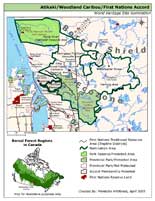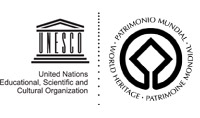
Manitoba World Heritage Site
Manitoba's World Heritage Site Nomination
| Neighbouring First Nations on Manitoba's east side have nominated their traditional lands to be protected from development. They signed an Accord in 2002, committing to work together for protection of their lands. Members of the Accord include four First Nations in Manitoba, and one First Nation in Ontario. As part of the process to secure both self-management and protection for their traditional lands, the Accord First Nations decided to pursue World Heritage Site status for their lands. | Proposed World Heritage Site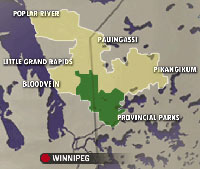 © CBC 2005 Larger Version |
| Discussions initiated by these First Nation communities for protection of their traditional territories and a future World Heritage Site in the region were acknowledged by the World Conservation Union (IUCN), which manages the world heritage sites program for UNESCO. This potential World Heritage Site also includes Atikaki Wilderness Park (Manitoba) and Woodland Caribou Park (Ontario). |
|
|
The WHS nomination area, Pimachiowin Aki (the land that gives life) is an area of 40, 000 km2 of boreal forest. It includes 5 traditional territories, parts of 2 provinces, three Provincial Parks (Atikaki, Atikaki South and Woodland Caribou Provincial Park), 4 proposed park additions, Eagle-Snowshoe Conservation Reserve in Ontario, and the Bloodvien River, a designated Canadian Heritage River. The area is critical habitat for the threatened Woodland Caribou and contains many archaeological sites important to First Nation history and culture. The intent is to seek World Heritage Site listing as both a natural landscape and heritage site. The nomination represents a potential World Heritage Site that is both naturally and culturally significant on a global basis and consistent with the current priority to secure Boreal forest WHS. (See What is a World Heritage Site? section).A June 2004 report resulting from an October 2003 international IUCN workshop to review and provide recommendations on potential World Heritage Sites for the boreal ecozone supports the Manitoba-Ontario First Nations-led nomination. Canada's Minister of the Environment also endorsed the First Nations' nomination by including it on Canada's updated Tentative List for World Heritage Sites, released in April 2004. |
|
View the "St. Petersburg Declaration" (excerpt of the October 2003 IUCN Workshop Report)  Download Protected
Areas and First Nation Resource Stewardship Accord (PDF) Download Protected
Areas and First Nation Resource Stewardship Accord (PDF)
 Download Pikangikum First Nation and The Partnership for Public Lands Agreement (PDF) Download Pikangikum First Nation and The Partnership for Public Lands Agreement (PDF) |
| The Manitoba First Nations involved in the Accord, and WHS nomination are currently in the process of securing legal protection for their lands and completion of lands management plans for their traditional territories. These are both community goals of the First Nations as well as being requirements for preparation of the WHS Nomination File (See Inscription Process above). | Proposed World Heritage Site Nomination - Pimachiowin Aki With Land Interests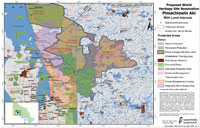 Larger Image |
View June 2008 Manitoba Wildlands Map: Proposed World Heritage Site Nomination - Pimachiowin Aki  View June 2008 Manitoba Widlands Map: Proposed World Heritage Site Nomination - Pimachiowin Aki With Ecoregions  View September 2008 Manitoba Widlands Map: Proposed World Heritage Site Nomination - Pimachiowin Aki With Land Interests  View Pimachiowin Aki - World Heritage Project Area Map View Pimachiowin Aki World Heritage Project Area Ecosystem Services Valuation Assessment 2008 (Summary Report) View Pimachiowin Aki World Heritage Project Area Ecosystem Services Valuation Assessment 2008 (Full report) East Side UNESCO Bid Submitted
The decision making process generally takes 18 months, as UNESCO officials consider the natural and cultural value of site. 4,000 pages of documents, videos, and photographs have been sent to UNESCO officials in Paris. They will be reviewed to ensure it is complete and will then be forwarded to UNESCO's technical advisors at the International Union for Conservation of Nature and the International Council on Monuments and Sites. Known as Pimachiowin Aki — Ojibway for "the land that gives life" — the nominated area encompasses 33,400 square kilometres of boreal forest, rivers, lakes and wetlands spread across eastern Manitoba and into Ontario. The nominated WHS includes Atikaki Provincial Park in Manitoba and Woodland Caribou Provincial Park in Ontario. Five First Nations started the designation bid in 2002 and will manage the lands with the Governments of Ontario and Manitoba. The five First Nations entered into an accord in 2002, which called for establishment of the WHS. "This is the completion of many years of effort by our partnership," commented Pikangikum First Nation representative and partnership cochairman Alex Peters. "Back in 1999 when our elders were considering planning issues related to Dedicated Protected Areas they wanted to create opportunities for future generations of our youth. It was at that time that they decided to pursue a World Heritage Site opportunity." Ontario Premier Dalton McGuinty said the UNESCO site "would stand as a proud example of co-operation among aboriginal peoples, the province of Ontario and the province of Manitoba." "We need to work together to take care of this land for people who live on the land and for visitors to the land. We also know that we are protecting it for children across the world who benefit from things that are often unseen like clean air and clean water," said Sophia Rabliauskas, spokesperson for Pimachiowin Aki. "What it means for Manitobans is that we are going to be globally recognized for what we have done to protect this site," said Manitoba Premier Greg Selinger. "It is Manitoba and Ontario's responsibility to design and protect these WHS lands. Road-building, mining and forestry operations will be allowed inside some areas of the proposed WHS, so it is not yet clear how much of the entire area will be protected," noted Manitoba Wildlands Director Gaile Whelan Enns. If the bid is successful, the region would join other UNESCO world heritage sites such as Australia's Great Barrier Reef, Arizona's Grand Canyon and Canada's Banff National Park. View January 20, 2012 Kenora Daily Miner articleView January 19, 2012 Winnipeg Free Press article View January 19, 2012 Winnipeg Sun article View January 18, 2012 Government of Manitoba News Release View Pimachiowin Aki World Heritage Project website View UNESCO World Heritage Centre website Sources: Daily Miner, CBC, Government of Manitoba
Manitoba Government WHS SupportManitoba Premier Doer, Conservation Minister Struthers, Hydro Minister Chomiak, and finance Minister Selinger all made public statements in support of the World Heritage Site nomination. Manitoba Wildlands has prepared a running list of these statements of support. From time to time we will be updating the list. Government support was made public in November 2004. Download Manitoba Government WHS Support Download Manitoba Government WHS Support  (PDF) Updated April 2008 (PDF) Updated April 2008World Conservation CongressIn November 2004, members of Poplar River First Nation traveled to the 3rd IUCN World Conservation Congress in Bangkok, Thailand, and participated in negotiations and meetings to arrive at final wording for a recommendation that went before the WCC Assembly.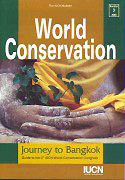 The recommendation, which calls on Canada, Russia, and all boreal forest nations to recognize, preserve and protect ecological processes that sustain the overall health of boreal forest regions, was accepted by the WCC. The recommendation makes specific reference to the need to "facilitate and continue to fund needed scientific, technical, indigenous and local community activity to assist in the nomination and designation of boreal forest regions as recognized international sites, for example, World Heritage Sites such as the indigenous led Atikaki/Woodland Caribou/Accord First Nations - Manitoba and Ontario nomination, recently placed on Canada's official Tentative List for World Heritage Sites."
The recommendation, which calls on Canada, Russia, and all boreal forest nations to recognize, preserve and protect ecological processes that sustain the overall health of boreal forest regions, was accepted by the WCC. The recommendation makes specific reference to the need to "facilitate and continue to fund needed scientific, technical, indigenous and local community activity to assist in the nomination and designation of boreal forest regions as recognized international sites, for example, World Heritage Sites such as the indigenous led Atikaki/Woodland Caribou/Accord First Nations - Manitoba and Ontario nomination, recently placed on Canada's official Tentative List for World Heritage Sites." Download WCC Recommendation CGR3.REC021 - Conservation of Canada's Boreal Forest (DOC) Download WCC Recommendation CGR3.REC021 - Conservation of Canada's Boreal Forest (DOC)View November 25, 2004 Manitoba Wildlands News Item  Poplar River First Nation Interview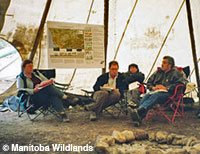 The Natural Resources Defense Council (NRDC) is featuring an interview with leaders of the Poplar River First Nation about the connection between protection of heir traditional boreal forest lands and the health and future of their community. The web site hosted interview refers to the ongoing process to achieve World Heritage Site status for the First Nation's lands, as part of the larger WHS nomination. The Natural Resources Defense Council (NRDC) is featuring an interview with leaders of the Poplar River First Nation about the connection between protection of heir traditional boreal forest lands and the health and future of their community. The web site hosted interview refers to the ongoing process to achieve World Heritage Site status for the First Nation's lands, as part of the larger WHS nomination.The interview is based on a conversation with Albert Bittern, Elder; Ernest Bruce, band manager; Victor Bruce, Elder; Ed Hudson, lands councilor; Ray Rabliauskas, land management coordinator; and Sofia Rabliauskas, councilor. Poplar River First Nation's lands are included in the NRDC's Heart of the Boreal BioGem campaign. View Poplar River Interview on the NRDC website Visit NRDC's Heart of the Boreal BioGem website Poplar River First Nation Lands PlanFor several years Poplar River First Nation has been involved in lands protection, lands planning, its own traditional use studies and arriving at its own lands management plan for the Asatiwisipe Aki Traditional Territory. Its territory of over one million hectares has mostly been protected from development by Manitoba regulation, at the request of the First Nation, starting in 1999.Since fall 2005 when the First Nation completed its lands plan, various presentations regarding its protected lands undertaking, and the World Heritage Site accord have been made. The lands plan has now also been presented to the Manitoba government. The First Nation has posted the lands management plan on its web site. As of September 2010 the Manitoba Government has not completed review of the plan. View Asatiwisipe Aki Lands Management PlanGoldman Award for Poplar River Woman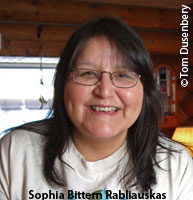 Sophia Bittern Rabliauskas, of Poplar River First Nation is one of six international activists to win a major international environmental award for efforts to secure permanent protection from development for the traditional lands of her people. Poplar River's traditional lands are located about 600 km northeast of Winnipeg in Manitoba's boreal forest.
Sophia Bittern Rabliauskas, of Poplar River First Nation is one of six international activists to win a major international environmental award for efforts to secure permanent protection from development for the traditional lands of her people. Poplar River's traditional lands are located about 600 km northeast of Winnipeg in Manitoba's boreal forest. Sophia Bittern Rabliauskas is the 2007 North American winner of the Goldman Environmental Prize, established in 1990 by San Francisco philanthropist Richard Goldman and his family. The award, worth US $125,000, is handed out every year to one person from each continent in recognition of grassroots environmental work. The recognition "means a lot," said Rabliauskas. "Not only I, but the whole community... has worked tirelessly to protect the boreal forest." Sophia Bittern Rabliauskas is the only Manitoban to ever win the award; only a handful of Canadians have won the award. Rabliauskas and the Poplar River Elders believe returning to the forest is the key to a healthier future. "To preserve the land means preserving our people," she said. Elders Said to Plan and Study
It all began over a decade ago, when community Elders made a decision that's directly responsible for the award decision. They told their sons and daughters that the Aboriginal wisdom wasn't enough to protect the land and their way of life anymore. They worried loggers would come to cut down the trees and governments would dam the rivers without consulting them. 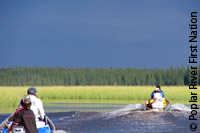 The Elders directed that the people should work with scientists to confirm that the land had a purpose beyond the bottom line and support the assertion that the people of Poplar River had a right to demand a say in the future of their traditional lands. This eventually evolved into the development of a comprehensive land protection and management plan - the Asatiwisipe Aki Lands Management Plan - a precedent-setting effort among First Nations in the world's boreal region.
The Elders directed that the people should work with scientists to confirm that the land had a purpose beyond the bottom line and support the assertion that the people of Poplar River had a right to demand a say in the future of their traditional lands. This eventually evolved into the development of a comprehensive land protection and management plan - the Asatiwisipe Aki Lands Management Plan - a precedent-setting effort among First Nations in the world's boreal region. Poplar River's plan is a full-scale blueprint of how the community is documenting, protecting and sustainably managing Poplar River's forests, wildlife and other natural resources. The plan outlines the following core components: respecting traditional knowledge; benefiting from environmental analysis; developing economic opportunities, including protection of traditional hunting, trapping and fishing activities; and creating sustainable tourism opportunities. Once Sophia Bittern Rabliauskas and Poplar River's current efforts to secure permanent protection of their land from the Manitoba government are realized, they will focus their energy on another goal - to achieve UNESCO World Heritage listing for a large boreal forest region in Manitoba and Ontario that encompasses Poplar River's lands. Interim protection by provincial regulation of these lands (from industrial development) has been in place since 1999. Poplar River First Nation has formally requested permanent protection steps from the Manitoba government. Lands plans, protected lands and a combined lands management strategy are essential for the World Heritage Site evaluation.  Download Manitoba Wildlands Brief about Poplar River protected lands Download Manitoba Wildlands Brief about Poplar River protected lands  (PDF) (PDF)View the Goldman profile, photos, and acceptance speech of Sophia Rabliauskas Visit the Poplar River First Nation website Watch the CBC video clip about Sophia and the Goldman Prize: Quick Time View the April 22, 2007 CBC Manitoba article  Download the April 22, 2007 Winnipeg Free Press: article 1 & article 2 (DOCs) Download the April 22, 2007 Winnipeg Free Press: article 1 & article 2 (DOCs)View the Winnipeg Free Press slideshow about Sophia and Poplar River First Nation  Download the April 22, 2007 Globe and Mail article Download the April 22, 2007 Globe and Mail articleView the April 22, 2008 MacLeans article View the April 23, 2007 Canadian Press article on Canada.com View the April 23, 2007 Manitoba Wildlands news item  Sources: CBC, Winnipeg Free Press, Goldman Environmental Foundation, Canadian Press |
|
World Heritage Site (WHS) ChronologyAtikaki / Woodland Caribou / First Nations Accord /World Heritage Site Nomination Current as of October 2010 |
2010
Continued World Heritage Site Chronology (2006-2002) |
World Heritage Site
 2002-2014
2002-2014


